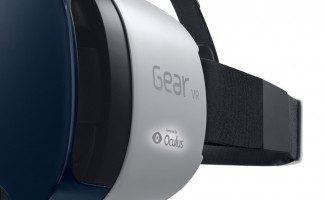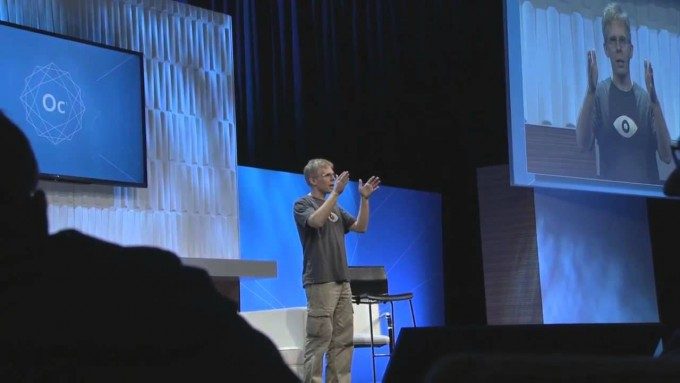There are two sorts of people in this world: those that have listened to John Carmack talk and those who are unenlightened. One of the key minds behind Doom and Quake is a most unlikely orator, but one who has the ability to hold the attention of a room full of geeks like no other. Anyone who’s witnessed his unscripted, unprompted streams of consciousness from his legendary Quakecon keynotes will know this, and for his inaugural talk as CTO of Oculus at their first developer event, ‘Connect’, he pulled no punches.
First Rule of Carmack: I Can Say What I Like and I Will!


You should take the time to watch the full keynote embedded above as it’s all massively interesting. But for the time poor or those with a deficit in attention span, I’ve picked some of my highlights and speculate what they tell us.
“The current killer limitations on Gear VR are the fact that it’s a 60Hz Low Persistence display which has flicker problems for a lot of people, and it has no positional tracking which is one of the critical aspects for DK2 and future products.” [@2m 53s]


Another thing that Oculus have said is that, in order to stand a chance of eliminating nausea whilst using a VR headsets, you need positional tracking, the lack of which on Gear VR is clearly something that irks Carmack. Furthermore any solution won’t be able to rely on anything like the Rift DK2’s outside-in IR LED tracking solution, which makes this a tough problem to crack. He’s got some ideas though, and if he and his team managed to squeeze sub-20ms latency out of a phone, you’ve got to think there’s a pretty good chance it’ll get solved one way or another.
“One of the things about hitching our train with Samsung here is that… Samsung’s technology ‘ticks’ twice a year, they have big product rollouts two times a year and we expect Gear VR to be following this path… it’s not going to be years between updates” [@7m 59s ]
From Carmack’s hints, it looks as if we could very well see new Gear VR devices every year. As it’s tied to a Galaxy Note, the pressure to refresh alongside updates to Samsung’s flagship phablet may be strong. I’m not sure that this relentless drive for ‘bigger’ and ‘faster’ necessarily equals ‘better’ though, especially in VR. Keeping product refreshes regular and maintaining tight standards for VR might be a challenge.
“DK2, if you’ve ever taken one apart, it’s basically a Note 3 screen” [@8m 33s]
See Also: The Touchscreen from a Samsung Smartphone is Hidden Inside Every Oculus Rift DK2
“…the last 5 frames per second that we get out of DK2 is actually by overclocking [the Note 3 screen] beyond what Samsung wants to do to the millions of Note 4’s that are going to ship out” [@10m 12s]
A nice insight into the hacking that must go on behind the scenes at Oculus and a reminder that they really are working beyond the bleeding edge most of the time. Clearly it was someone’s job to find out if a high enough sample of Note 3 screens could sustain the 75Hz required for their lower watermark (rather than the ideal 90Hz) for acceptable flicker when using low persistence techniques. Clearly the answer was ‘a lot’ as 75Hz is what every DK2 runs at.
A good reminder too of the juxtaposition Oculus and Samsung find themselves in with VR versus mobile tech. Clearly the needs for one will differ greatly from the other, something Carmack alludes to many times in his talk.
“There’s very little likelihood that we’re going to see these small displays run at 120Hz or even 90Hz at the size they’re designed for…” [@11m 23s]
The DK2 uses a Note 3 display, it’s small with a good resolution (1080p) and it can be used ‘off the shelf’ with what sounds like firmware or driver hacks to increase the refresh rate. The one thing that Oculus have confirmed about the Crescent Bay display (and almost nothing else) is that it is running at 90Hz, OLED, and allows low persistence.
Therefore, unless they’re using Note 4 displays that are hand selected and crazy overclocked, Crescent Bay may not use a display that’s in an existing or forthcoming mobile device. Which means that Crescent Bay may well be sporting a custom OLED panel produced specially for VR and specifically the Oculus Rift. Speculation has flowed on whether a custom panel would allow the company to offer a higher horizontal FOV, something Palmer Luckey previously said would be desirable for CV1.
As I say, insert whatever speculation gif you need into this section—I found it interesting nevertheless.
“The next [step after dual interlacing] would be going for a deeper interlaced display, instead of going every other line, start going every 8th line so you have 8 times as many fields, or every 16 lines for 16 times as many fields, that would give us the kilohertz display that we would really like to see.” [@15:04]
And this is where John Carmack blows my mind. He’s been labelled as a FPS stickler before, and here he quickly skips from a discussion on the benefits of a refresh rate that’s easily divisible by common video frame rates (i.e. 60Hz-120Hz) to outlining the ‘kilohertz display’. A 1000Hz ‘deep interlaced’ technique that Carmack maintains may well be possible with today’s components and some additional jiggery pokery.
A display running at this rate could frankly look phenomenal whilst offering a neat fix for lower latency and is perfect for use with VR. Bizarre to think that techniques which we all believed had died with cathode ray tube displays actually may make a comeback in this newest of platforms.
That’s just a few of the more quotable moments of Carmack’s talk; frankly though those 90 mins are stacked with interesting insight into his relationship and product building with Samsung plus some glimpses into the inner workings of Oculus and some outlandish tech projects on the horizon.
What’s clear throughout is that he’s like a kid in a candy store and that his enthusiasm and seemingly limitless capacity to dig deeper and find solutions other’s hadn’t considered. As a result, it’s pretty clear that hiring John Carmack as CTO was probably one of the smartest things Oculus has done yet.

